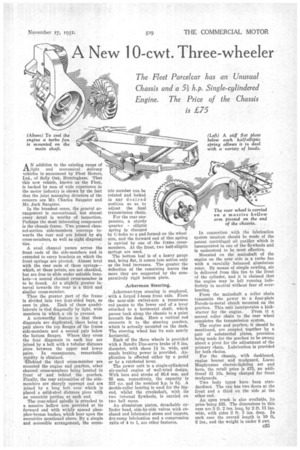A New 1 0-cwt. Three-wheeler
Page 57

If you've noticed an error in this article please click here to report it so we can fix it.
The Fleet Parcelcar has an Unusual Chassis and a 51 h.p. Single-cylindered Engine. The Price of the Chassis is £75
AN addition to the existing range of light and economical delivery vehicles is announced by Fleet Motors, Ltd., of Sally Oak, Birmingham. That this new vehicle, known as the Fleet, is backed by men of wide experience in the motor industry is shown by the fact that the joint managing directors of the concern are Mr. Charles Sangster and Mr. Jack Sangster.
In the broadest sense, the general arrangement is conventional, but almost every detail is worthy of inspection. Perhaps the most interesting component is the chassis frame. Two pressed channel-section side-members converge towards the rear and are joined by six cross-members, as well as eight diagonal ties. • A steel channel passes across the front ends of the side-members and is extended to carry brackets on which the front springs are pivoted. Almost level with the rear ends of these springs— which, at these points, are not shackled, but are free to slide under suitable brackets—a second channel cross-member is to be found. At a slightly greater interval towards the rear is a third and similar cross-member.
Thus the greater Part of the frame is divided into two four-sided bays, as
seen in plan. Each of these quadrilaterals is tied diagonally by light, wide members in which a rib is pressed.
A noteworthy feature is that these diagonals are duplicated, there being a pair above the top flanges of the frame side-members and a second pair below the bottom flanges. Where they cross the four diagonals in each bay are joined by a bolt with a tubular distance piece between the upper and lower pairs. In consequence, remarkable rigidity is obtained.
=$Behind the third cross-member are mounted the engine and gearbox, other channel cross-members being located in front of and behind the gearbox. Finally, the rear extremities of the sidemembers are sharply upswept and are joined by a long bolt over which is placed a solid-steel distance piece with an eccentric portion at each end.
The rear-wheel spindle is attached to a massive hollow arm provided at its forward end with widely spaced phosphor-bronze bushes, which bear upon the eccentrics mentioned above. By a simple and accessible arrangement, the eccen
tric member can be rotated and locked in any desired position so as to adjust the final transmission chain.
For the rear suspension, a sturdy quarter elliptic spring is clamped by 1.1-bolts to a pad formed on the wheel arm, and the forward end of this spring is carried by one of the frame crossmembers. At the front, two half-elliptic springs are used.
The bottom leaf is of a heavy gauge and, being flat, it comes into action only as the load increases. The greater the deflection of the remaining leaves the more they are supported by the comparatively rigid bottom plate.
Ackerman Steering.
Ackerman-type steering is employed, with a forged I-beam front axle. From the near-side swivel-arm a trend-verse rod pasSes to the lower end of a lever attached to a horizontal shaft, which passes back along the chassis to a point beneath the dash. Here a vertical rod connects it to the steering gearbox, which is actually mounted on the dash. The steering wheel has its axis nearly horizontal.
Each of the three wheels is provided with a Bendix Duo-servo brake of 8 ins. diameter, with shoes 1f in. wide, and ample braking power is provided. Application is effected either by a pedal or by a ratcheted lever.
The power unit is a single-cylindered air-cooled engine of well-tried design. With bore and stroke of 80.4 mm. and 95 mm. respectively, the capacity is 557 c.c. and the nominal h.p. is 54. A double-roller bearing is used for the bigend, whilst the crankshaft, with its two internal flywheels, is carried on two ball races.
An aluminium piston, detachable cylinder head, side-by-side valves with enclosed and lubricated stems and tappets, dry-sump lubrication and a compression ratio of 4 to 1, are other features. In
connection with the lubrication system mention should be made of the patent centrifugal oil purifier which is incorporated in one of the flywheels and is understood to be most effective.
Mounted on the mainshaft of the engine on the near side is a turbo fan with a carefully balanced aluminium rotor. By means of simple cowling, air is delivered from this fan to the front of the cylinder, and it is claimed that the engine may be left running indefinitely in neutral without fear of overheating.
From the mainshaft a roller chain transmits the power to a four-plate Ferodo-to-metal clutch mounted on the gearbox. This unit incorporates a kick starter for the engine. From it a second roller chain to the rear wheel completes the transmission system.
The engine and gearbox, it should be mentioned, are coupled together by a pair of substantial plates, provision being made for the gearbox to be swung about a pivot for the adjustment of the primary chain. Lubrication is provided for both chains.
For the chassis, with dashboard, engine bonnet and mudguard, Lucas Magdynamo electric-lighting set and horn, the retail price is £75, an addi tional 10s. being charged for front mudguards. • Two body types have been standardized. The van has two doors at the front and a third on the side at the other end.
An open truck is also available, its price beim,b £85. The dimensions in this case are 5ft. 2 ins, ions., by 2 ft. 11 ins. wide, with sides 2 ft. b3 ins. deep. In each case the overall length is 10 ft.
8 ins., and the weight is under 8 cwt. In












































































































